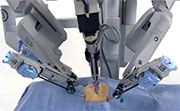
TUESDAY, Feb. 19 (HealthDay News) — Nearly 10 percent of hysterectomies in the United States are performed robotically, say researchers who found the “robo” procedures jumped dramatically between 2007 and 2010.
But they question whether robotic surgery is preferable to another minimally invasive procedure, laparoscopic surgery, for women having their uterus removed for non-cancerous conditions. While the two procedures have similar complication rates, the robotically assisted hysterectomy costs roughly $2,200 more than the laparoscopic procedure, according to the new study.
“The robotically assisted procedure was substantially more expensive,” said the study’s lead author, Dr. Jason Wright, an assistant professor of obstetrics and gynecology at Columbia University College of Physicians and Surgeons, in New York City.
Wright said more work is needed to determine which women would benefit from robotic hysterectomy.
“This data also raises a lot of questions about surgical innovations and the need to find ways to better study them before they diffuse into practice,” he added.
Results of the study are published in the Feb. 20 issue of the Journal of the American Medical Association.
Hysterectomy is a common treatment for non-cancerous gynecological conditions, such as fibroids, endometriosis and excessive bleeding. As many as one in nine U.S. women will undergo such a procedure, according to the study.
Different surgical techniques exist for performing a hysterectomy. One choice is traditional open surgery, where a surgeon removes the uterus through a 5- to 7-inch opening in the abdomen. Another is vaginal hysterectomy — removal of the uterus through the vaginal opening. Laparoscopy is done with special tools that allow surgeons to perform the surgery using only small incisions. Robotically assisted surgery is similar to laparoscopic surgery, but the surgeon uses a robotic device instead of a laparoscope to do the procedure.
Dr. Michael Zinner, chief of surgery at Brigham and Women’s Hospital in Boston, said there are advantages to robotically assisted surgery in certain situations.
“The robotic device is easy to learn,” Zinner said. “The wrist on the machine gives you [greater flexibility] unlike a straight laparoscope that’s more like a chopstick. If the surgeon has any slight tremor, the machine evens it out,” he said. In cases such as prostate surgery, where the surgery must take place in a very confined space and there’s a significant risk of nerve damage, the delicate, articulating robotic device can be ideal, he said.
But for larger areas of the body, a laparoscope generally works just as well. “Nobody talks about using robotic surgery for removing the gallbladder,” noted Zinner, because it would be more expensive without providing an additional benefit. Zinner co-wrote an editorial in the same issue of the journal.
In the current study, Wright and his colleagues reviewed data from more than 264,000 women who had a hysterectomy for a non-cancerous condition.
Robotically assisted hysterectomies were performed 0.5 percent of the time in 2007. By 2010, that number had jumped to 9.5 percent. The rate of laparoscopic surgery also increased during this time period, from 24.3 percent to 30.5 percent, according to the study.
At hospitals that introduced robotically assisted hysterectomy, its use quickly rose, the study found. But at hospitals without the robotic option, use of laparoscopic hysterectomy increased during the same time period. Overall, abdominal and vaginal hysterectomies declined.
Robotically assisted hysterectomy was less likely to lead to a hospital stay of two days or more compared to laparoscopic surgery, but the two procedures were similar in all other measured complications.
Where the two procedures differed most significantly was in cost, with $6,679 the median fee for a laparoscopic hysterectomy versus $8,868 for the robotically assisted procedure.
Joel Weissman, deputy director and chief scientific officer at the Center for Surgery and Public Health at Brigham and Women’s Hospital and co-author of the editorial, said the robotic machine costs about $1.5 million and requires extra personnel.
“It’s a little bit unclear who’s paying the extra cost,” he said. “It seems like at this point in time, insurers are paying the same whether the surgery is robotically assisted or not. But hospitals have to somehow pay those extra costs.”
If you’re considering a robotically assisted procedure, Zinner and Weissman advised talking with your doctor about which procedure will deliver better results. If two procedures are similarly effective, they suggested comparing costs.
In the case of hysterectomy, because robotically assisted surgery and laparoscopic surgery have similar results but significantly different costs, Zinner said he’d like to see more surgeons training in the laparoscopic procedure.
More information
Learn more about robotically assisted surgery from the U.S. National Library of Medicine.

